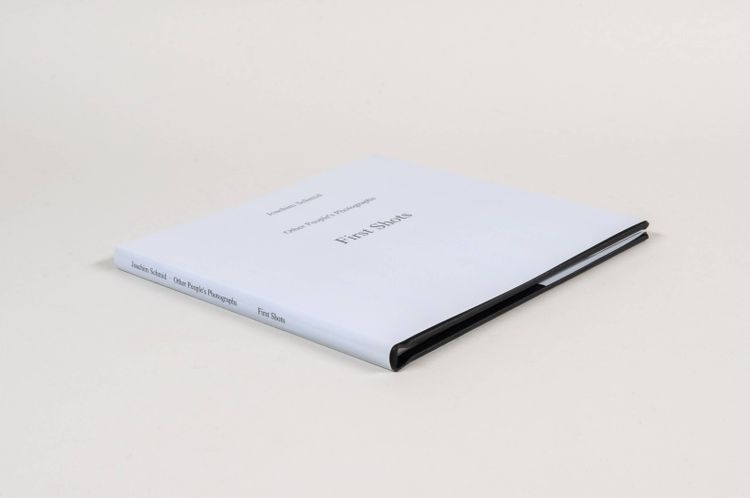“Assembled between 2008 and 2011, this series of ninety-six books explores the themes and visual patterns presented by modern everyday, amateur photographers. Images found on photo sharing sites such as Flickr have been gathered and ordered in a way to form a library of contemporary vernacular photography in the age of digital technology and online photo hosting. Each book is comprised of [32] images that focus on a specific photographic event or idea, the grouping of photographs revealing recurring patterns in modern popular photography. The approach is encyclopedic, and the number of volumes is virtually endless but arbitrarily limited. The selection of themes is neither systematic nor does it follow any established criteria—the project’s structure mirrors the multifaceted, contradictory and chaotic practice of modern photography itself, based exclusively on the motto ‘You can observe a lot by watching’” (Joachim Schmid, “Other People’s Photographs,” website).
Some of the chosen categories’ titles “are rather obvious, some of them surprising, some rather general and all-encompassing, some very specific, thus creating a taxonomy and subverting the system of categorization at the same time” (Joachim Schmid, “Attitudes and Approaches,” interview). Some motifs, such as the photographer’s Shadow, Mugshots, or Faces in Holes, are familiar; others, such as the Self(ie) with an outstretched arm, concrete poetry on Fridge Doors, Airline Meals, and camera packaging (apparently the most popular motif for First Shots) reveal new image genres; others still, such as Parking Lots, are certainly inspired in their grouping by the tradition of Ed Ruscha, for example.
Since this project represents a kind of artistic research on generic image types, Schmid prefers to speak of “textbooks” or “image books” (“Bilderbücher”) rather than “photobooks.” It is not only a captivating panorama of popular visual culture, but also a unique historical documentation: each book is dated to the exact month in which the image material was collected, because Schmid was aware from the beginning that there are patterns that may be extremely popular temporarily, but then disappear again.
For the design of the books, which in the early years of Blurb always had to be done via the in-house software (simply uploading a ready-made PDF was not possible), Schmid chose to follow the standard solutions proposed by the platform and its software, in order to find out what the generic pattern was here, too. Therefore, with this series, you have the typical Blurb book of those years in your hand: a square hardcover with a dust jacket, and it becomes abundantly clear that the technology and the platform were not invented for artists but for wedding albums, baby books, travel journals, and the like.
As the project has evolved over the years, this series also manifests the countless changes in print-on-demand production: over time, both the paper and the color tone of the gray dust jackets changed several times, at some point Blurb began to print production barcodes on the back, and so on. In order to maintain consistency, the series can now only be purchased as a complete boxed set, numbered and signed, directly from the artist. He also adds the date of production for new orders so that the changes can be historically documented. In addition, the production quality is also often a source of trouble. While the artist stopped production with Blurb for most of his other books due to increasing annoyances and switched to Lulu, he is forced to continue relying on Blurb for this series.
A two-volume paperback print-on-demand edition including all 3,072 photographs (18 x 18 cm, two volumes, 400 pages each) is available for budget collectors. The fact that exactly ninety-six chapters with thirty-two photos each fit into this two-volume version decided on the total number of individual volumes in the series. The project has received a lot of attention and is listed in Gerry Badger and Martin Parr’s seminal The Photobook: A History (volume three).
The project’s home page presents all ninety-six volumes with photographs of each cover, one sample spread, and the first spread of every chapter of the paperback edition. It also includes the following copyright notice: “All of the photographs used in this work as documentary material are merely integrating parts of a larger artwork. They do not constitute reprints or duplications in breach of the fee provisions of copyright law.”
The series includes these titles: Airline Meals · Airports · Another Self · Apparel · At Work · Bags · Big Fish · Bird’s Eyes · Black Bulls · Blue · Bread · Buddies · Cash · Cheques · Cleavage · Coffee · Collections · Colour · Commodities · Contents · Currywurst · Damage · Digits · Documents · Dogs · Drinks · Encounters · Evidence · Eyes · Faces in Holes · Fauna · Feet · First Shots · Fish · Flashing · Food · Fridge Doors · Gathered Together · Gender · Geology · Hands · Happy Birthday · Hotel Rooms · Images · Impact · In Motion · Indexes · Information · Interaction · Kisses for Me · Lego · Looking · Maps · Mickey · Models · More Things · Mugshots · News · Nothing Wrong · November 5th, 2008 · Objects in Mirror · On the Road · Parking Lots · Pictures · Pizza · Plush · Portraits · Postcards · Purple · Pyramids · Real Estate · Red · Room with a View · Self · Sex · Shadow · Shirts · Shoes · Silvercup · Sites · Size Matters · Space-Time · Statues · Sunset · Surface · Targets · Television · The Other Picture · The Picture · Things · Trophies · Tropic of Capricorn · Various Accidents · Wanted · Writings · You Are Here.

